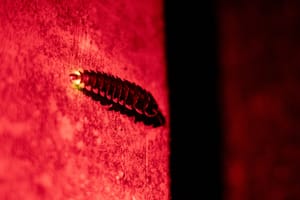Photos by Arieff Zafir.
IT WAS A particularly cool night. The crickets and rustling trees humbled the group into quietude. If not for distant car honks and the call to prayer from a nearby mosque through the darkness, it was easy to assume we were far from the city. But here in Bukit Kiara, in the heart of one of KL’s few green lungs, we huddled together on the lookout for tiny glows of fireflies.
For me, this was unlike my previous explorations to understand these little wonderful insects. The last time I did this, I was floating on a boat that snaked through the rivers of Matang’s mangrove forest reserve in Perak. The landscape was shadowed by trees that blinked with synchronised flashes from a congregation of fireflies. Aside from these glows, we were completely wrapped in darkness and silence. That reporting trip for the Malaysian environmental portal, Macaranga, brought me into the world of firefly conservation and the researchers and communities working to protect their glow. In most places that offer firefly tours, including at Penang’s Nibong Tebal riverbanks, the search for fireflies involved boat tours in far-flung areas away from the city.





